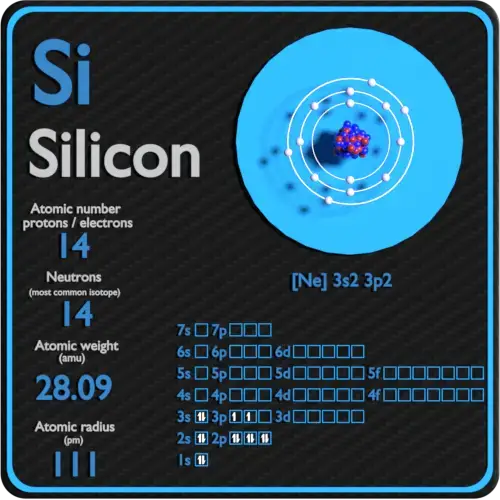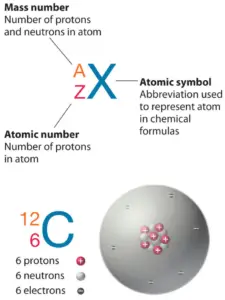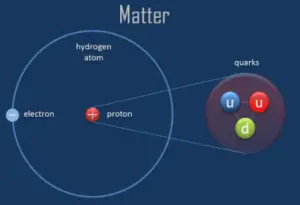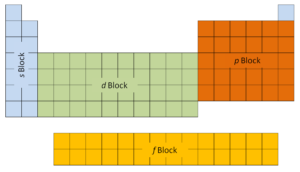
Silicon is a hard and brittle crystalline solid with a blue-gray metal lustre, it is a tetravalent metalloid and semiconductor. Most silicon is used industrially without being purified, and indeed, often with comparatively niggling processing from its natural form. Hyperpure silicon metal and doped hyperpure silicon (doping with boron, phosphorous, gallium, or arsenic) are used in solar cells, transistors and semiconductors.
Silicon of 96–99% purity is fabricated by reducing quartzite or sand with highly pure coke. The reduction is carried out in an electric arc furnace.
Protons and Neutrons in Silicon
 Silicon is a chemical element with atomic number14 which means there are 14 protons in its nucleus. Total number of protons in the nucleus is called theatomic number of the atom and is given thesymbol Z. The total electrical charge of the nucleus is therefore +Ze, where e (elementary charge) equals to1,602 x ten-19 coulombs.
Silicon is a chemical element with atomic number14 which means there are 14 protons in its nucleus. Total number of protons in the nucleus is called theatomic number of the atom and is given thesymbol Z. The total electrical charge of the nucleus is therefore +Ze, where e (elementary charge) equals to1,602 x ten-19 coulombs.
The total number of neutrons in the nucleus of an atom is called theneutron number of the cantlet and is given thesymbol N. Neutron number plus atomic number equals atomic mass number:N+Z=A. The difference between the neutron number and the atomic number is known as theneutron excess: D = N – Z = A – 2Z.
For stable elements, there is commonly a variety of stable isotopes. Isotopes are nuclides that take the same atomic number and are therefore the same chemical element, but differ in the number of neutrons. Mass numbers of typical isotopes of Silicon are28; 29; 30.
Principal Isotopes of Silicon
Naturally occurring silicon is equanimous of three stable isotopes, 28Si (92.23%), 29Si (4.67%), and 30Si (iii.10%). Out of these, only 29Si is of utilize in NMR and EPR spectroscopy, as it is the simply one with a nuclear spin (I = 1/2).
Silicon-28 is composed of 14 protons, 14 neutrons, and 14 electrons.
Silicon-29 is equanimous of 14 protons, 15 neutrons, and 14 electrons.
Silicon-30 is composed of 14 protons, xvi neutrons, and xiv electrons.
Electrons and Electron Configuration
The number of electrons in an electrically-neutral cantlet is the aforementioned as the number of protons in the nucleus. Therefore, the number of electrons in neutral cantlet of Silicon is 14. Each electron is influenced by the electric fields produced by the positive nuclear charge and the other (Z – i) negative electrons in the cantlet.
Since the number of electrons and their arrangement are responsible for the chemical behavior of atoms, thediminutive number identifies the various chemical elements. The configuration of these electrons follows from the principles of breakthrough mechanics. The number of electrons in each chemical element'southward electron shells, especially the outermost valence beat out, is the master cistron in determining its chemical bonding behavior. In the periodic table, the elements are listed in gild of increasing atomic number Z.
Electron configuration ofSiliconis[Ne] 3s2 3p2.
Possible oxidation states are-4; ..; +four.
It is a member of group 14 in the periodic table: carbon is in a higher place information technology; and germanium, tin, and pb are below it. It is relatively unreactive. Crystalline bulk silicon is rather inert, but becomes more than reactive at high temperatures. Like its neighbour aluminium, silicon forms a thin, continuous surface layer of silicon dioxide (SiO2) that protects the metal from oxidation.
Nigh Common Compound of Silicon
Silicon is almost widely distributed in space in cosmic dusts, planetoids, and planets as various forms of silicon dioxide (silica) or silicates. More than 90% of the Globe's crust is equanimous of silicate minerals, making silicon the 2nd most abundant element in the Globe'south crust (about 28% by mass), after oxygen. The most mutual compound of silicon is quartz. Quartz is a chemical compound consisting of one part silicon and 2 parts oxygen. Information technology is silicon dioxide (SiO2). The atoms are linked in a continuous framework of SiO4 silicon-oxygen tetrahedra, with each oxygen beingness shared between two tetrahedra, giving an overall chemic formula of SiO2.
Nigh Protons
 A proton is one of the subatomic particles that make up matter. In the universe, protons are abundant, making upabout one-half of all visible matter. Information technology hasa positive electrical accuse (+1e) and a remainder mass equal to 1.67262 × 10−27 kg (938.272 MeV/c two )— marginally lighter than that of the neutron but nearly 1836 times greater than that of the electron. The proton has a mean square radius of about 0.87 × 10−xv m, or 0.87 fm, and it is a spin – ½ fermion.
A proton is one of the subatomic particles that make up matter. In the universe, protons are abundant, making upabout one-half of all visible matter. Information technology hasa positive electrical accuse (+1e) and a remainder mass equal to 1.67262 × 10−27 kg (938.272 MeV/c two )— marginally lighter than that of the neutron but nearly 1836 times greater than that of the electron. The proton has a mean square radius of about 0.87 × 10−xv m, or 0.87 fm, and it is a spin – ½ fermion.
The protons exist in the nuclei of typical atoms, along with their neutral counterparts, the neutrons. Neutrons and protons, commonly callednucleons, are leap together in the atomic nucleus, where they account for 99.nine per centum of the atom'due south mass. Research in high-energy particle physics in the 20th century revealed that neither the neutron nor the protonis not the smallest building block of affair.
Well-nigh Neutrons
A neutron is 1 of the subatomic particles that brand up affair. In the universe, neutrons are abundant, making upwardlymore half of all visible matter. It hasno electric charge and a rest mass equal to 1.67493 × 10−27 kg—marginally greater than that of the proton but nigh 1839 times greater than that of the electron. The neutron has a mean square radius of nearly 0.8×x−xv k, or 0.8 fm, and it is a spin-½ fermion.
Atomic nuclei consist of protons and neutrons, which concenter each other throughthe nuclear strength, while protons repel each other viathe electric strength due to their positive accuse. These ii forces compete, leading to various stability of nuclei. There are only sure combinations of neutrons and protons, which formsstable nuclei.
Neutrons stabilize the nucleus, considering they attract each other and protons , which helps offset the electrical repulsion between protons. As a result, as the number of protons increases,an increasing ratio of neutrons to protons is needed to course a stable nucleus. If there are likewise many or too few neutrons for a given number of protons, the resulting nucleus is not stable and information technology undergoes radioactivity.Unstable isotopesdecay through various radioactive disuse pathways, most usually blastoff disuse, beta decay, or electron capture. Many other rare types of decay, such equally spontaneous fission or neutron emission are known. Information technology should be noted that all of these disuse pathways may be accompanied bythe subsequent emission of gamma radiation. Pure alpha or beta decays are very rare.
About Electrons and Electron Configuration
The periodic table is a tabular brandish of the chemical elements organized on the basis of their atomic numbers, electron configurations, and chemical properties. The electron configuration is the distribution of electrons of an atom or molecule (or other concrete construction) in atomic or molecular orbitals. Knowledge of theelectron configuration of dissimilar atoms is useful in agreement the structure of the periodic table of elements.
Every solid, liquid, gas, and plasma is composed of neutral or ionized atoms. Thechemical backdrop of the atom are determined by the number of protons, in fact, by number andarrangement of electrons. Theconfiguration of these electrons follows from the principles of quantum mechanics. The number of electrons in each element's electron shells, specially the outermost valence shell, is the master factor in determining its chemical bonding behavior. In the periodic table, the elements are listed in order of increasing atomic number Z.
Information technology is thePauli exclusion principle that requires the electrons in an cantlet to occupy different energy levels instead of them all condensing in the footing state. The ordering of the electrons in the ground country of multielectron atoms, starts with the everyman free energy country (footing state) and moves progressively from at that place up the energy scale until each of the atom's electrons has been assigned a unique gear up of breakthrough numbers. This fact has primal implications for the edifice up of the periodic table of elements.
 The get-go two columns on the left side of the periodic table are where thes subshells are being occupied. Because of this, the first ii rows of the periodic table are labeled thes block. Similarly, thep blockare the right-about six columns of the periodic table, thed cakeis the middle 10 columns of the periodic table, while thef blockis the 14-column section that is normally depicted as discrete from the main trunk of the periodic table. It could be part of the main body, simply then the periodic table would be rather long and cumbersome.
The get-go two columns on the left side of the periodic table are where thes subshells are being occupied. Because of this, the first ii rows of the periodic table are labeled thes block. Similarly, thep blockare the right-about six columns of the periodic table, thed cakeis the middle 10 columns of the periodic table, while thef blockis the 14-column section that is normally depicted as discrete from the main trunk of the periodic table. It could be part of the main body, simply then the periodic table would be rather long and cumbersome.
For atoms with many electrons, this note can become lengthy and and then an abbreviated notation is used. The electron configuration tin can be visualized as the core electrons, equivalent to thenoble gas of the preceding period, and the valence electrons (e.chiliad. [Xe] 6s2 for barium).
Oxidation States
Oxidation states are typically represented past integers which may be positive, aught, or negative. About elements have more one possible oxidation state. For example, carbon has nine possible integer oxidation states from −4 to +4.
The current IUPAC Aureate Book definition of oxidation state is:
"Oxidation state of an cantlet is the charge of this atom afterward ionic approximation of its heteronuclear bonds…"
and the term oxidation number is near synonymous. An chemical element that is not combined with any other different elements has an oxidation land of 0. Oxidation country 0 occurs for all elements – it is only the element in its elemental form. An atom of an element in a compound will take a positive oxidation state if it has had electrons removed. Similarly, adding electrons results in a negative oxidation land. Nosotros have as well distinguish betwixt the possible and common oxidation states of every chemical element. For example, silicon has nine possible integer oxidation states from −4 to +four, but simply -4, 0 and +four are common oxidation states.
Summary
| Element | Silicon |
| Number of protons | xiv |
| Number of neutrons (typical isotopes) | 28; 29; 30 |
| Number of electrons | 14 |
| Electron configuration | [Ne] 3s2 3p2 |
| Oxidation states | -iv; ..; +4 |

Source: www.luciteria.com
Other properties of Silicon
![]()
 Silicon is a chemical element with atomic number14 which means there are 14 protons in its nucleus. Total number of protons in the nucleus is called theatomic number of the atom and is given thesymbol Z. The total electrical charge of the nucleus is therefore +Ze, where e (elementary charge) equals to1,602 x ten-19 coulombs.
Silicon is a chemical element with atomic number14 which means there are 14 protons in its nucleus. Total number of protons in the nucleus is called theatomic number of the atom and is given thesymbol Z. The total electrical charge of the nucleus is therefore +Ze, where e (elementary charge) equals to1,602 x ten-19 coulombs.![]()

 A proton is one of the subatomic particles that make up matter. In the universe, protons are abundant, making upabout one-half of all visible matter. Information technology hasa positive electrical accuse (+1e) and a remainder mass equal to 1.67262 × 10−27 kg (938.272 MeV/c two )— marginally lighter than that of the neutron but nearly 1836 times greater than that of the electron. The proton has a mean square radius of about 0.87 × 10−xv m, or 0.87 fm, and it is a spin – ½ fermion.
A proton is one of the subatomic particles that make up matter. In the universe, protons are abundant, making upabout one-half of all visible matter. Information technology hasa positive electrical accuse (+1e) and a remainder mass equal to 1.67262 × 10−27 kg (938.272 MeV/c two )— marginally lighter than that of the neutron but nearly 1836 times greater than that of the electron. The proton has a mean square radius of about 0.87 × 10−xv m, or 0.87 fm, and it is a spin – ½ fermion. The get-go two columns on the left side of the periodic table are where thes subshells are being occupied. Because of this, the first ii rows of the periodic table are labeled thes block. Similarly, thep blockare the right-about six columns of the periodic table, thed cakeis the middle 10 columns of the periodic table, while thef blockis the 14-column section that is normally depicted as discrete from the main trunk of the periodic table. It could be part of the main body, simply then the periodic table would be rather long and cumbersome.
The get-go two columns on the left side of the periodic table are where thes subshells are being occupied. Because of this, the first ii rows of the periodic table are labeled thes block. Similarly, thep blockare the right-about six columns of the periodic table, thed cakeis the middle 10 columns of the periodic table, while thef blockis the 14-column section that is normally depicted as discrete from the main trunk of the periodic table. It could be part of the main body, simply then the periodic table would be rather long and cumbersome.
0 Response to "How Many Protons In Silicon"
Post a Comment